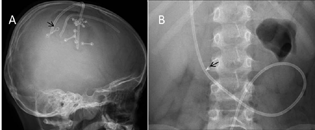Translate this page into:
Cranial Screw Migration along the Subdural Peritoneal Shunt Catheter in a Pediatric Patient
Buse Baykoca-Arslan, MD Department of Public Health, Texas Tech University Health Sciences Center 3601 4th Street, Lubbock, TX 79430 United States drbusebaykoca@gmail.com
This article was originally published by Thieme Medical and Scientific Publishers Pvt. Ltd. and was migrated to Scientific Scholar after the change of Publisher.
Abstract
Abstract
Craniotomy is a common surgery used to expose the brain by removing a part of the bone from the skull. During surgery, bone flaps can be fixed by using variety of materials that can migrate in the long term. A 7-year-old boy presented several years after the craniotomy and subdural peritoneal (SP) shunt surgeries. It was decided to remove the shunt catheter, and during the diagnostic tests, we saw that a loosened titanium screw has migrated along the SP shunt catheter from the skull into the abdominal wall. To the best of our knowledge, this is the first case in the reported electronic literature for a pediatric patient with a subcutaneous migration of a screw along the shunt catheter.
Keywords
subdural peritoneal shunt
subcutaneous migration
screw migration
pediatric neurosurgery
Introduction
Craniotomy is a common surgery used to expose the brain by removing a part of the bone from the skull.1 There are different approaches for fixing the bone flap for craniotomy, one of which is titanium plates and screws.2 Sometimes this hardware can loosen and usually remain in the same location.3 In this case, a titanium screw migrated from the skull into the abdominal area. The existence of the subdural peritoneal (SP) shunt had facilitated this. To the best of our knowledge, this is the first case in the reported electronic literature for a pediatric patient with a subcutaneous migration of a screw along the shunt catheter.
Case Report
A 7-year-old boy presented us with an SP shunt with bilateral proximal catheters. In the patient history, he was operated with a craniotomy to evacuate subdural hematoma due to a nonaccidental trauma when he was an infant. He also developed subdural hygroma and a SP shunt with bilateral proximal catheters was placed after the incident. After 6 years, the patient represented to our clinic for the assessment if he is still in need of SP shunt. After clamping the SP shunt and intracranial pressure monitoring, we assured that the patient was not in need of SP shunt anymore. We decided to perform an SP shunt catheter removal surgery. However, during the diagnostic tests we saw that a screw has migrated along the SP shunt catheter from the skull into the abdominal wall (Fig. 1). The screw was removed successfully together with the shunt catheter by doing an incision over the screw (Fig. 2).

-
Fig. 1 (A) Skull X-rays with absent screw at the insertion site (arrow), where it migrated along the shunt catheter in to the abdominal area seen on an abdominal X-ray (B).
Fig. 1 (A) Skull X-rays with absent screw at the insertion site (arrow), where it migrated along the shunt catheter in to the abdominal area seen on an abdominal X-ray (B).

-
Fig. 2 The image of the screw removed from abdominal area.
Fig. 2 The image of the screw removed from abdominal area.
Discussion
In this report, a titanium screw migration along the SP shunt catheter was observed and it was removed carefully during the SP shunt removal surgery.
There are some reported cases of subcutaneous migration of needles. For instance, in a case report, a broken dental needle has been reported as a subcutaneous migration from the mandibular gingiva to the neck that caused mild swelling in the neck area.4 However, subcutaneous migration of a surgical hardware, such as a screw, has not been reported in the literature.
There has been a debate on how to secure the bone flap in the pediatric population.5 As an alternative to titanium hardware, nonabsorbable sutures or absorbable plates and screws can be used. Complications due to the used materials in craniotomy could be seen in long term. The most common long-term complications of craniotomy are infection, bone resorption, and skin erosions.6 Our case led us to conclude that titanium hardware can migrate and can be defined as a rare complication of craniotomy. We suggest that alternative bone fixation methods such as absorbable screws or stiches should be considered to prevent hardware migration.
Conflict of Interest
None declared.
Funding None.
References
- Craniotomy for treatment of chronic subdural hematoma. Neurosurg Clin N Am. 2017;28(2):229-237.
- [Google Scholar]
- Migration of a dissected peritoneal shunt catheter into the scrotum. Brain Dev. 1984;6(3):336-338.
- [Google Scholar]
- Subcutaneous migration of a broken dental needle from the mandibular gingiva to the neck: a case report. Tokai J Exp Clin Med. 2020;45(3):108-112.
- [Google Scholar]
- Long-term complications of cranioplasty using stored autologous bone graft, three-dimensional polymethyl methacrylate, or titanium mesh after decompressive craniectomy: a single-center experience after 596 procedures. World Neurosurg. 2019;128:e841-e850.
- [Google Scholar]







